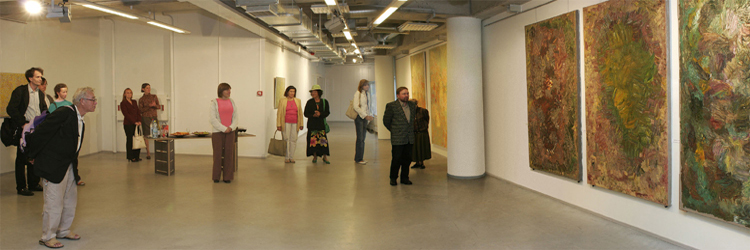A shorter version in Estonian initially published in:
A Walk in the Galleries of Tallinn. Two Stops: at Andrei Maksimjuk's exhibition "All about Roses" in the Artdepoo up to October 24 and at Ove Büttner's exhibition in the Art & Design Gallery at Viru Centre up to October 20 // Sirp (2005), Sept. 9.
Büttner's Atoms
Ove Büttner = Owe Büttner = Owe Byttner = Ove Byttner. Letters are linguistic atoms that form word combinations. That sometimes remain the same. Perhaps not accidentally the artist who bears four orthographically correct names paints is four clearly distinguishable styles: 1. Cubistic figural compositions; 2. Symbolist, predominantly religious visions with hidden images; 3. Works, painted in abstract expressionistic style; 4. Paintings that have been composed of colour dots. The first style the most closely relates the art of Ove Büttner with the French school, making him yet another non-Pallas-Frenchman in the Estonian art. In the second, he is inspired by Odilon Redon's treatment of colour and contour. In the third, he pours his emotions into quick impasto form. A Seurat-like analytical pointillism has been seen in the fourth style. The spotted raster of four-color print that overflows us from every journal, pixel screen and bus stop advertisement has deepened the understanding of a dot as the element of painting technique, manner or method. Ove's painting is rather the whole synthesised from the dots as elementary particles. Like art deco in National Romantic monumental and applied arts that followed the formation of new historical associations, being at the same time their background or model. Or the harmony of mosaics of the Byzantine art that have been stowed out of the pieces of glass and stone.
When the French school is considered, then a vital trait is tended to be overlooked: the quest for truth. The paintings in Ove Büttner's first group are the closest to the search for truth in form in the first half of the previous century. The works in the second group focus on essential truths. What are the times of old, the Middle Ages, nationalism and sanctity? How to depict the culmination of the Calvary mystery that according to descriptions took place in Cimmerian darkness? The third group expresses the artist's impulse emotions and pangs. What is the truth of the fourth group's dots? The departure of souls on the atomic level, says the artist himself. It all indeed begins from the optical analyses as in the case of Seurat. Ove has kept all the spectacles of his relatives. From time to time, he looks at his paintings through them, making his glance shady for a moment. It reminds of the flickering of the eye during long minutes of staring out of the window that the child has time for. The dots, first and foremost, seize with movement. Ove presents a microscopic photo of the butterfly wing that consists of separate colourful plaques set along the aerodynamic lines of the wing. They take a grip already before the beginning of the flight. In this way, the dots are the atoms of the soul that imbibe into the vortex.
During the opening speech of the exhibition, a blowfly flew into the eye of a visitor. Apparently, the pupil of the eye proved to be sufficiently attractive dot for deviating the fly from its course towards Ove's canvas. But the gravitation of the dots on the painting was overwhelming; the fly descended to its yellow macrocosm as a black dot and died. Why just the fly? Why not also the grapes on the gallery's dish, or the caramels in colurful wrapping papers? The same visitor set the candies between the grapes into the composition, following the example of Ove's paintings, and inadvertently caused the collapse of biscuits. It gave the rise to the rebuke that nobody digs in biscuits with unwashed hands. The fly, the berries, candies, visitors, health principles, eyewitnesses, the atoms of the collective body of Viru Centre's gallery pushed together a proper squabble. Then the fear of infection vanished and the whirl turned into a joint chew. Altarbread is also a dot of biscuit indeed, a God's atom in the palm of the clergyman.
Translated by Tiina Vilberg
